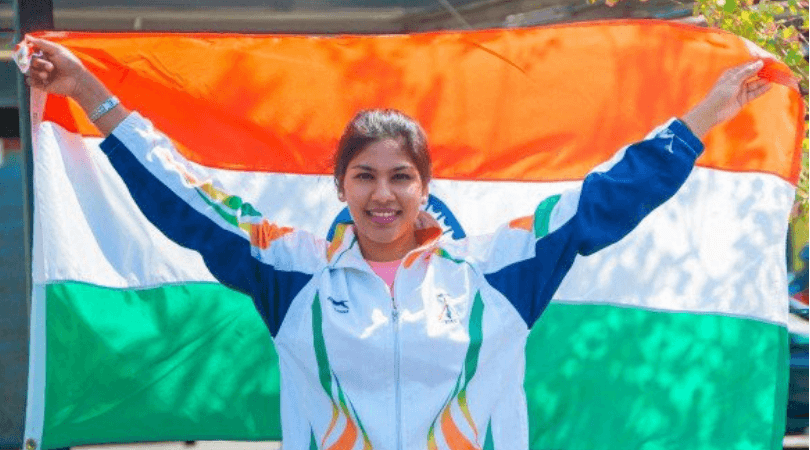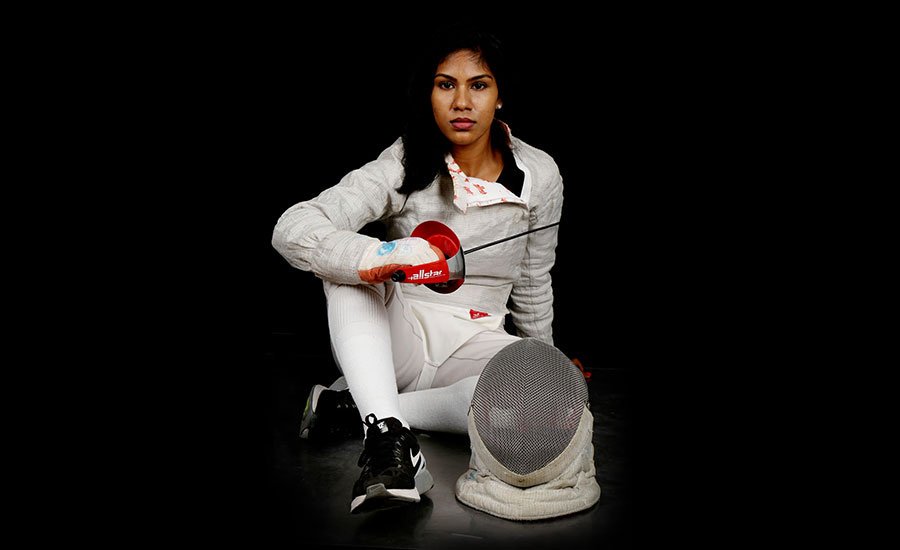Begin typing your search above and press return to search.
Featured
Fencing: The breakout of Bhavani Devi and her Tokyo 2020 chances
Bhavani Devi had a breakout performance at the ongoing World Fencing Championships, in the Individual Women's Sabre event.

Bhavani Devi (current World No. 67) had a breakout performance at the ongoing World Fencing Championships, in the Individual Women's Sabre event. Bhavani started her campaign against World No. 61 Azza Besbes of Tunisia in the round of 64. She began slowly and went down 0-4 at the start, but clawed back to eventually take a 10-8 lead before Besbes equalized at 10-10. And then, Bhavani just ran away with the match to win 15-10. In the round of 32, she came up against World No. 36 Gabriella Page (CAN), who had just beaten the World No. 3 Sofia Pozdniakova of Russia. The clear underdog, Bhavani once again started off slowly going down 2-5. While she was thereafter able to keep pace with the Canadian, this time she couldn't quite close the gap and was essentially facing 3 match points at 11-14. https://twitter.com/TheBridge_IN/status/1152526464593436672 And then it happened. Bhavani found her resolve, dug deep, upped her game, and in the face of defeat won 4 touches in a row to win 15-14 and advance to the round of 16. As Bhavani let out a celebratory shriek, her Italian coach Nicola Zanotti was in tears on the sideline.  Tokyo 2020 will see medals handed out in individual as well as team events for all the 3 weapons. In the individual event, each match consists of three 3-minute rounds with a 1-minute rest period between rounds. The first fencer to score 15 touches wins, or if no one is able to reach 15 touches after 3 rounds, then the higher score at the end of 3 rounds wins. In case of a tie at the end of 3 rounds, there is a 1-minute sudden death period. There is also a concept of "priority" or "right of way" in Foil and Sabre. This can be quite confusing but essentially says that the fencer initiating the attack has priority, and in case both fencers touch the other almost simultaneously (i.e., with a gap of less than 1 second), then the fencer deemed to have priority is awarded the point. In Épée however, there is no concept of priority and both fencers are awarded a point in case of near-simultaneous touches.
Tokyo 2020 will see medals handed out in individual as well as team events for all the 3 weapons. In the individual event, each match consists of three 3-minute rounds with a 1-minute rest period between rounds. The first fencer to score 15 touches wins, or if no one is able to reach 15 touches after 3 rounds, then the higher score at the end of 3 rounds wins. In case of a tie at the end of 3 rounds, there is a 1-minute sudden death period. There is also a concept of "priority" or "right of way" in Foil and Sabre. This can be quite confusing but essentially says that the fencer initiating the attack has priority, and in case both fencers touch the other almost simultaneously (i.e., with a gap of less than 1 second), then the fencer deemed to have priority is awarded the point. In Épée however, there is no concept of priority and both fencers are awarded a point in case of near-simultaneous touches.
But the day was not over for the 25-year old Bhavani. Far from it!
Next up was Bianca Pascu (ROU). Now, while Pascu is currently World No. 19, she is a former World No. 5 and defeated the Reigning Olympic Champion Yana Egorian (RUS) in the first round. Beating Page was great but this was next level completion. Bhavani started well this time, going toe to toe with Pascu till 3-3. But then Pascu turned up the heat and started running away with the match, as she took an incredible 13-5 lead. As commentators started speculating about how dangerous Pascu is, and who she might face next, and how she is bossing Bhavani, and if she could go all the way, Bhavani had a bit of a comeback but still faced a whopping 6 match points at 8-14. And then, once again, it happened. As the commentators were left aghast and could just keep repeating "Wow", Bhavani just kept racking up the touches and levelled the match at 14-14. Could she do it? Could she complete a mind-boggling comeback a second time, only this time doubly more mind-boggling? This was no small tournament, this was no weak opponent. She was literally one touch away from the quarter-finals of the World Championships. But alas, it was not meant to be. She unfortunately gave up the deciding touch and sunk to her haunches, having put in a heroic and memorable breakout performance. And as it turned out, Bianca Pascu went on to win bronze.So what does this mean for Tokyo 2020?
Obviously, despite her heroics, calling her a realistic medal hope would be jumping the gun way too soon, and a bit foolhardy. She is not at that level, not yet at least, and has miles to go before attaining that status. But, she has put herself firmly in the qualification race for Tokyo and has a great chance of becoming the first Indian Olympic fencer. And if she gets there, with a little bit of luck, she might even pull off a win or two. Before looking at her qualification chances in detail, first let's look at the sport of fencing.Introduction to Fencing
Fencing sport consists of events in 3 different weapons, or swords, at the Olympic level – Épée, Foil and Sabre. It is said that the fencing blade is the 2nd fastest moving object in all of sport, behind only the bullet in shooting, though some doubts have been raised about this claim. All events require the fencer to touch the opponent with their weapon in order to score a point. In Épée and Foil, scoring touches have to be made only with the tip of the sword, whereas in Sabre, touches can be made with any part of the sword. Further, in Épée, the entire body of the opponent is a valid target for a scoring touch, but in Sabre only the upper body, excluding the hands, is a valid target, i.e., head, neck, arms and torso. And in Foil, only the torso is the valid target for scoring touches. Tokyo 2020 will see medals handed out in individual as well as team events for all the 3 weapons. In the individual event, each match consists of three 3-minute rounds with a 1-minute rest period between rounds. The first fencer to score 15 touches wins, or if no one is able to reach 15 touches after 3 rounds, then the higher score at the end of 3 rounds wins. In case of a tie at the end of 3 rounds, there is a 1-minute sudden death period. There is also a concept of "priority" or "right of way" in Foil and Sabre. This can be quite confusing but essentially says that the fencer initiating the attack has priority, and in case both fencers touch the other almost simultaneously (i.e., with a gap of less than 1 second), then the fencer deemed to have priority is awarded the point. In Épée however, there is no concept of priority and both fencers are awarded a point in case of near-simultaneous touches.
Tokyo 2020 will see medals handed out in individual as well as team events for all the 3 weapons. In the individual event, each match consists of three 3-minute rounds with a 1-minute rest period between rounds. The first fencer to score 15 touches wins, or if no one is able to reach 15 touches after 3 rounds, then the higher score at the end of 3 rounds wins. In case of a tie at the end of 3 rounds, there is a 1-minute sudden death period. There is also a concept of "priority" or "right of way" in Foil and Sabre. This can be quite confusing but essentially says that the fencer initiating the attack has priority, and in case both fencers touch the other almost simultaneously (i.e., with a gap of less than 1 second), then the fencer deemed to have priority is awarded the point. In Épée however, there is no concept of priority and both fencers are awarded a point in case of near-simultaneous touches. Tokyo Qualification
Tokyo Qualification for fencing is primarily based on World Rankings – Team World Rankings as well as Individual World Rankings. For every weapon and gender, the top 4 teams on the Team World Rankings as on April 4, 2020 will qualify a team, consisting of 3 fencers each. Then, from among the teams ranked 5th – 16th, the top team from each continent – Europe, Asia-Oceania, Africa and Pan America – will qualify. If any continent doesn't have a team ranked in the 5th – 16th range, then the highest ranked team not already qualified will take their place. Once the team qualification has been determined, each of the fencers participating in the team event will compete in the corresponding individual event as well. And, in addition, 10 individual fencers per event will qualify from countries that do not already have a team, with a maximum of 1 fencer per country. Of these 10 individual fencers, two will be the highest ranked eligible fencers in Europe, two will be the highest ranked in Asia-Oceania, one highest ranked in Africa and one highest ranked in Pan-America. In addition, there will 4 continental qualification tournaments in April 2020 – one for each continent – consisting only of fencers not qualified via rankings, with the winners punching their ticket to Tokyo.Bhavani's path to Olympics
Currently, in Bhavani's Women's Sabre event, Korea and China are ranked World No. 5 & 7 respectively, and look poised to qualify teams (as the highest ranked African team is Tunisia at World No. 20 and thus outside the qualification range). After them, Japan is likely to take the 1st individual Asian ranking spot, currently having fencers with World Ranks 27, 29, 38 and 39. The second individual Asian ranking spot is currently a race between WR 60 Aigerim Sarybay (KAZ), WR 63 Hin Wai Lam (HKG), and WR 67 Bhavani Devi. And with this R16 performance, Bhavani should be able to increase her ranking to around the 45-50 range, putting her in prime position to win this race for that last ranking spot. Still, a lot of time is left between now and April, and things can easily change. In particular, Indian fans should really hope that BOTH China and Korea qualify teams (or Japan at current World No. 9 does so), because even if one of them misses out, they will take up an individual Asian ranking spot, thus leaving the final Asian qualification tournament as Bhavani's only hope. Of course, after this World Championship performance, she is likely to start as one of the favourites in that tournament as well, if she needs to compete.Next Story

